Strategy to Reduce Employee Turnover in Aged Care: A Research Project
VerifiedAdded on 2023/06/10
|43
|8070
|407
Project
AI Summary
This research project explores strategies to reduce employee turnover in aged care companies, motivated by observations of poor job satisfaction and lack of motivation among staff. The study identifies factors such as job satisfaction, job alternatives, career growth, reward, recognition, employee engagement, and communication as key contributors to turnover. Through statistical analysis, the research evaluates the impact of high turnover rates on aged care operations and proposes mitigation strategies. The project includes a literature review, research methodology detailing data collection and analysis techniques, findings from quantitative analysis and regression analysis, and concludes with recommendations for aged care organizations to improve employee retention and overall operational effectiveness. The aim is to provide actionable insights for addressing the prevalent issue of high turnover in the aged care sector.
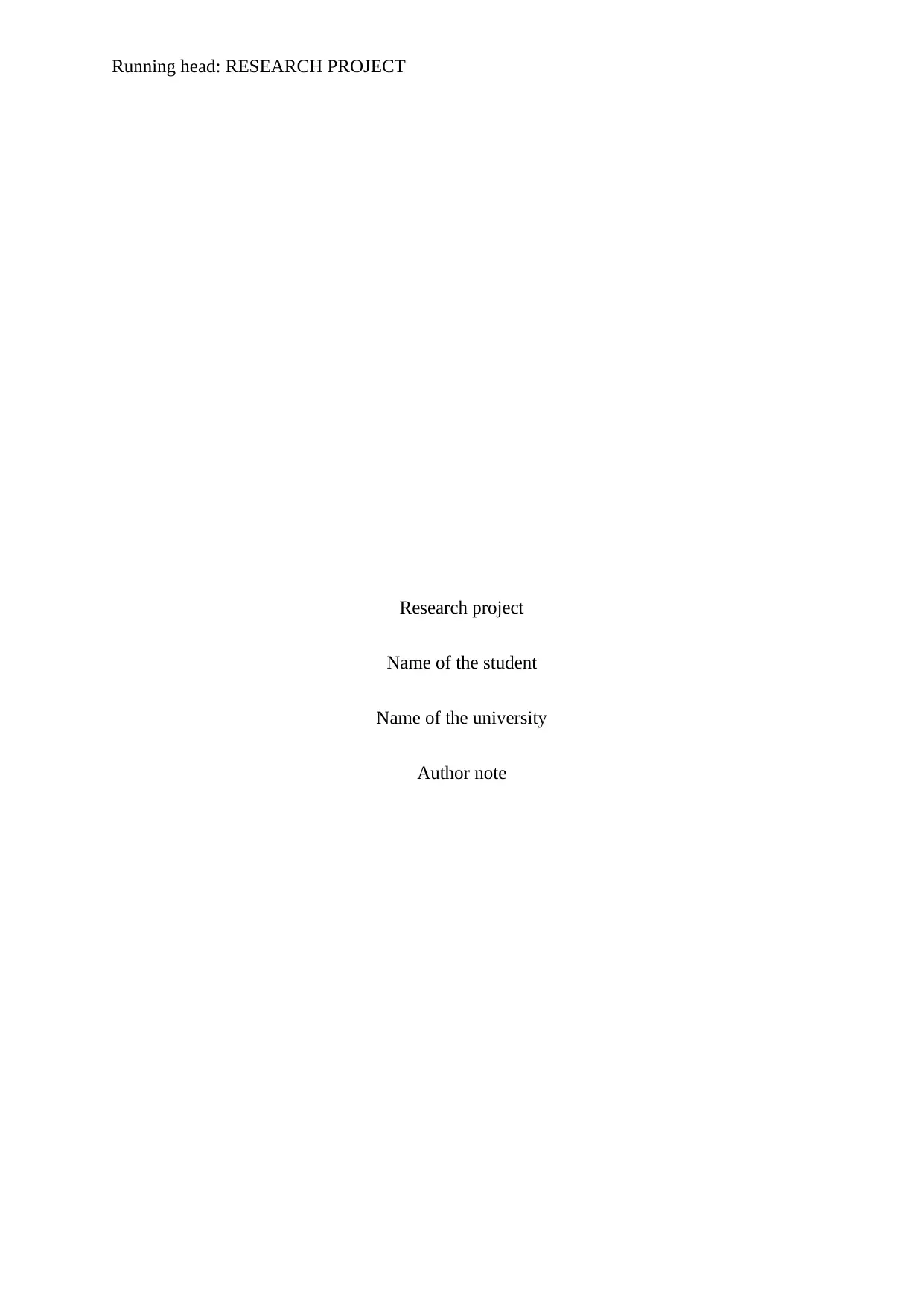
Running head: RESEARCH PROJECT
Research project
Name of the student
Name of the university
Author note
Research project
Name of the student
Name of the university
Author note
Paraphrase This Document
Need a fresh take? Get an instant paraphrase of this document with our AI Paraphraser
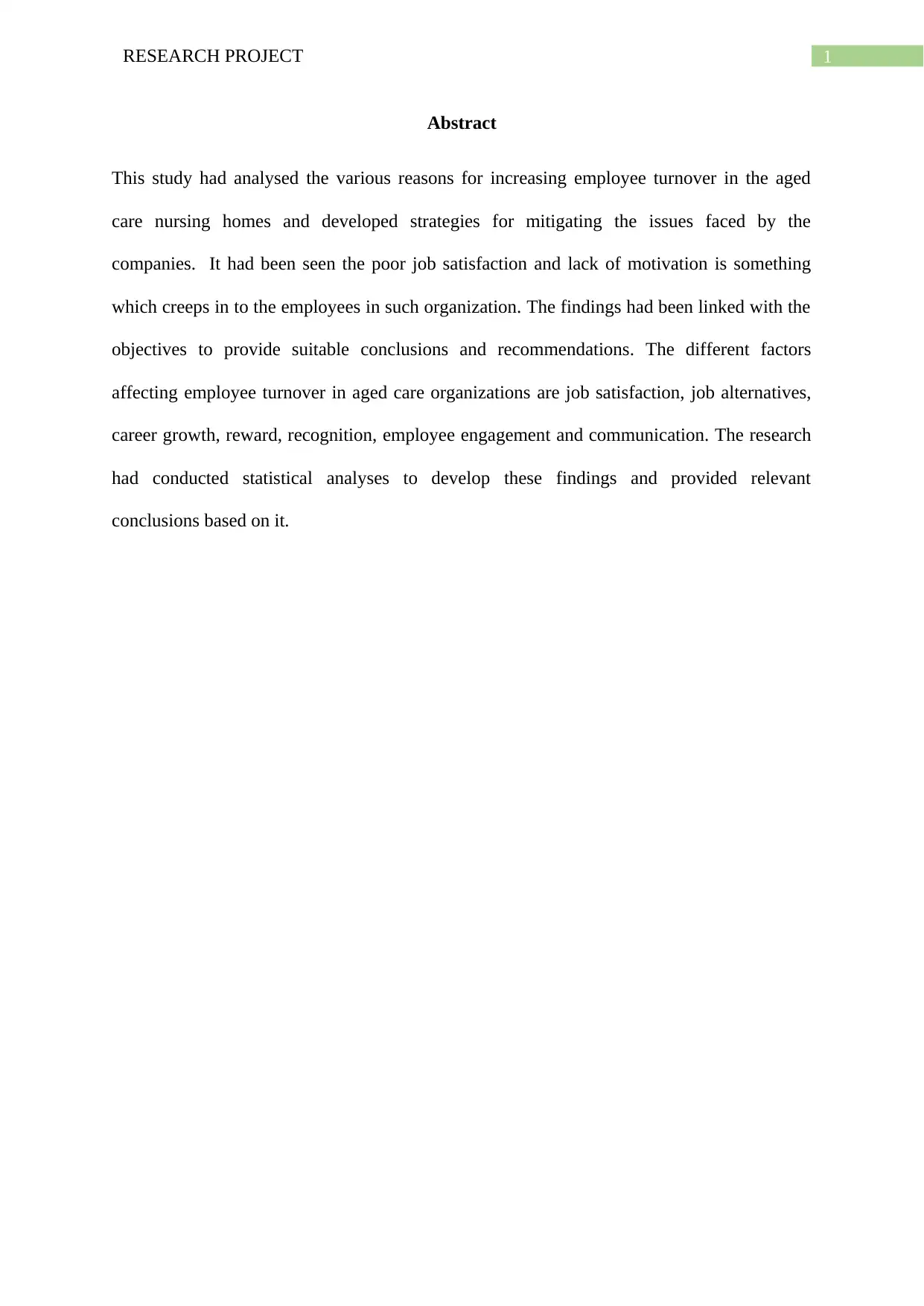
1RESEARCH PROJECT
Abstract
This study had analysed the various reasons for increasing employee turnover in the aged
care nursing homes and developed strategies for mitigating the issues faced by the
companies. It had been seen the poor job satisfaction and lack of motivation is something
which creeps in to the employees in such organization. The findings had been linked with the
objectives to provide suitable conclusions and recommendations. The different factors
affecting employee turnover in aged care organizations are job satisfaction, job alternatives,
career growth, reward, recognition, employee engagement and communication. The research
had conducted statistical analyses to develop these findings and provided relevant
conclusions based on it.
Abstract
This study had analysed the various reasons for increasing employee turnover in the aged
care nursing homes and developed strategies for mitigating the issues faced by the
companies. It had been seen the poor job satisfaction and lack of motivation is something
which creeps in to the employees in such organization. The findings had been linked with the
objectives to provide suitable conclusions and recommendations. The different factors
affecting employee turnover in aged care organizations are job satisfaction, job alternatives,
career growth, reward, recognition, employee engagement and communication. The research
had conducted statistical analyses to develop these findings and provided relevant
conclusions based on it.
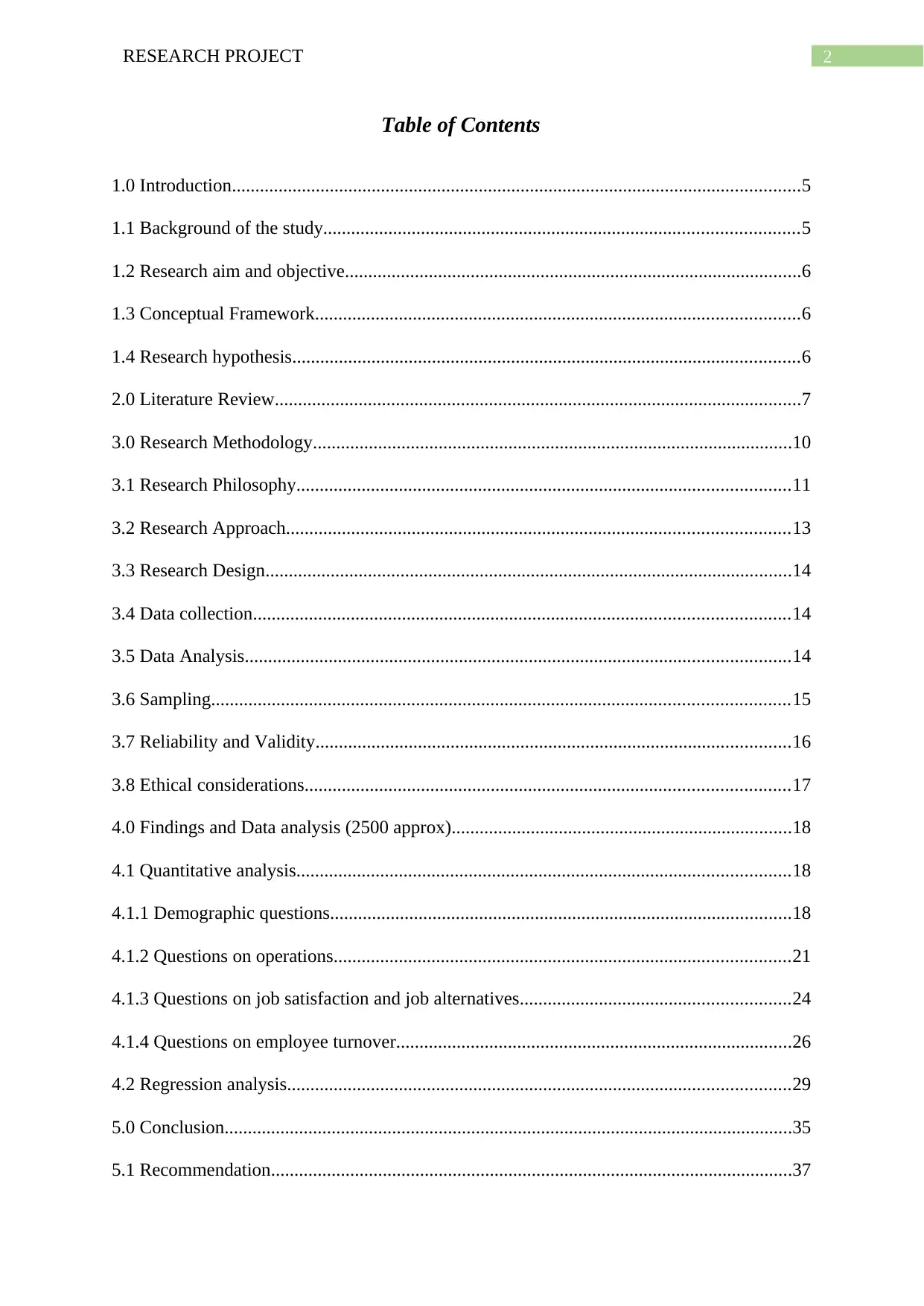
2RESEARCH PROJECT
Table of Contents
1.0 Introduction..........................................................................................................................5
1.1 Background of the study......................................................................................................5
1.2 Research aim and objective..................................................................................................6
1.3 Conceptual Framework........................................................................................................6
1.4 Research hypothesis.............................................................................................................6
2.0 Literature Review.................................................................................................................7
3.0 Research Methodology.......................................................................................................10
3.1 Research Philosophy..........................................................................................................11
3.2 Research Approach............................................................................................................13
3.3 Research Design.................................................................................................................14
3.4 Data collection...................................................................................................................14
3.5 Data Analysis.....................................................................................................................14
3.6 Sampling............................................................................................................................15
3.7 Reliability and Validity......................................................................................................16
3.8 Ethical considerations........................................................................................................17
4.0 Findings and Data analysis (2500 approx).........................................................................18
4.1 Quantitative analysis..........................................................................................................18
4.1.1 Demographic questions...................................................................................................18
4.1.2 Questions on operations..................................................................................................21
4.1.3 Questions on job satisfaction and job alternatives..........................................................24
4.1.4 Questions on employee turnover.....................................................................................26
4.2 Regression analysis............................................................................................................29
5.0 Conclusion..........................................................................................................................35
5.1 Recommendation................................................................................................................37
Table of Contents
1.0 Introduction..........................................................................................................................5
1.1 Background of the study......................................................................................................5
1.2 Research aim and objective..................................................................................................6
1.3 Conceptual Framework........................................................................................................6
1.4 Research hypothesis.............................................................................................................6
2.0 Literature Review.................................................................................................................7
3.0 Research Methodology.......................................................................................................10
3.1 Research Philosophy..........................................................................................................11
3.2 Research Approach............................................................................................................13
3.3 Research Design.................................................................................................................14
3.4 Data collection...................................................................................................................14
3.5 Data Analysis.....................................................................................................................14
3.6 Sampling............................................................................................................................15
3.7 Reliability and Validity......................................................................................................16
3.8 Ethical considerations........................................................................................................17
4.0 Findings and Data analysis (2500 approx).........................................................................18
4.1 Quantitative analysis..........................................................................................................18
4.1.1 Demographic questions...................................................................................................18
4.1.2 Questions on operations..................................................................................................21
4.1.3 Questions on job satisfaction and job alternatives..........................................................24
4.1.4 Questions on employee turnover.....................................................................................26
4.2 Regression analysis............................................................................................................29
5.0 Conclusion..........................................................................................................................35
5.1 Recommendation................................................................................................................37
⊘ This is a preview!⊘
Do you want full access?
Subscribe today to unlock all pages.

Trusted by 1+ million students worldwide
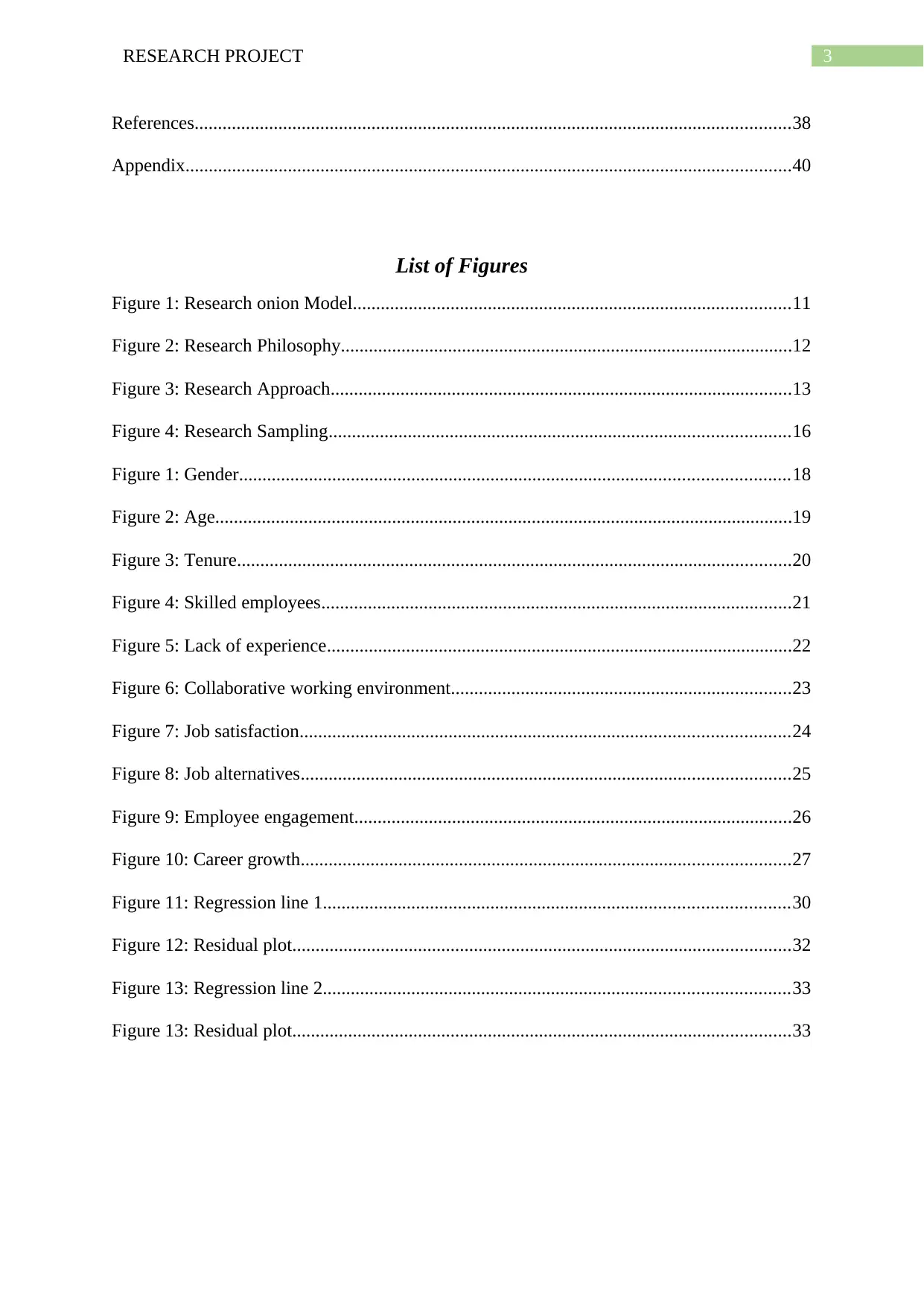
3RESEARCH PROJECT
References................................................................................................................................38
Appendix..................................................................................................................................40
List of Figures
Figure 1: Research onion Model..............................................................................................11
Figure 2: Research Philosophy.................................................................................................12
Figure 3: Research Approach...................................................................................................13
Figure 4: Research Sampling...................................................................................................16
Figure 1: Gender......................................................................................................................18
Figure 2: Age............................................................................................................................19
Figure 3: Tenure.......................................................................................................................20
Figure 4: Skilled employees.....................................................................................................21
Figure 5: Lack of experience....................................................................................................22
Figure 6: Collaborative working environment.........................................................................23
Figure 7: Job satisfaction.........................................................................................................24
Figure 8: Job alternatives.........................................................................................................25
Figure 9: Employee engagement..............................................................................................26
Figure 10: Career growth.........................................................................................................27
Figure 11: Regression line 1....................................................................................................30
Figure 12: Residual plot...........................................................................................................32
Figure 13: Regression line 2....................................................................................................33
Figure 13: Residual plot...........................................................................................................33
References................................................................................................................................38
Appendix..................................................................................................................................40
List of Figures
Figure 1: Research onion Model..............................................................................................11
Figure 2: Research Philosophy.................................................................................................12
Figure 3: Research Approach...................................................................................................13
Figure 4: Research Sampling...................................................................................................16
Figure 1: Gender......................................................................................................................18
Figure 2: Age............................................................................................................................19
Figure 3: Tenure.......................................................................................................................20
Figure 4: Skilled employees.....................................................................................................21
Figure 5: Lack of experience....................................................................................................22
Figure 6: Collaborative working environment.........................................................................23
Figure 7: Job satisfaction.........................................................................................................24
Figure 8: Job alternatives.........................................................................................................25
Figure 9: Employee engagement..............................................................................................26
Figure 10: Career growth.........................................................................................................27
Figure 11: Regression line 1....................................................................................................30
Figure 12: Residual plot...........................................................................................................32
Figure 13: Regression line 2....................................................................................................33
Figure 13: Residual plot...........................................................................................................33
Paraphrase This Document
Need a fresh take? Get an instant paraphrase of this document with our AI Paraphraser
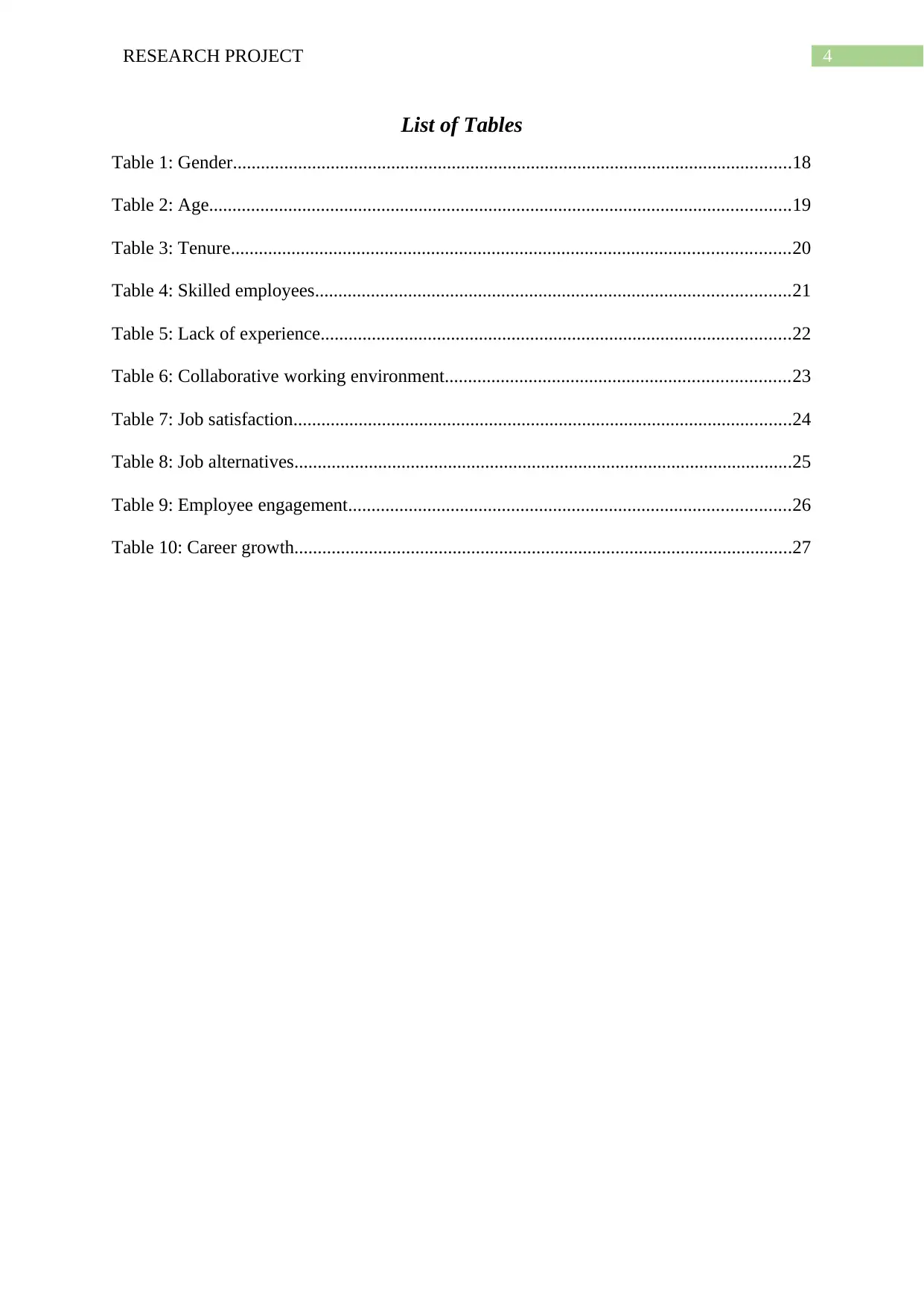
4RESEARCH PROJECT
List of Tables
Table 1: Gender........................................................................................................................18
Table 2: Age.............................................................................................................................19
Table 3: Tenure........................................................................................................................20
Table 4: Skilled employees......................................................................................................21
Table 5: Lack of experience.....................................................................................................22
Table 6: Collaborative working environment..........................................................................23
Table 7: Job satisfaction...........................................................................................................24
Table 8: Job alternatives...........................................................................................................25
Table 9: Employee engagement...............................................................................................26
Table 10: Career growth...........................................................................................................27
List of Tables
Table 1: Gender........................................................................................................................18
Table 2: Age.............................................................................................................................19
Table 3: Tenure........................................................................................................................20
Table 4: Skilled employees......................................................................................................21
Table 5: Lack of experience.....................................................................................................22
Table 6: Collaborative working environment..........................................................................23
Table 7: Job satisfaction...........................................................................................................24
Table 8: Job alternatives...........................................................................................................25
Table 9: Employee engagement...............................................................................................26
Table 10: Career growth...........................................................................................................27
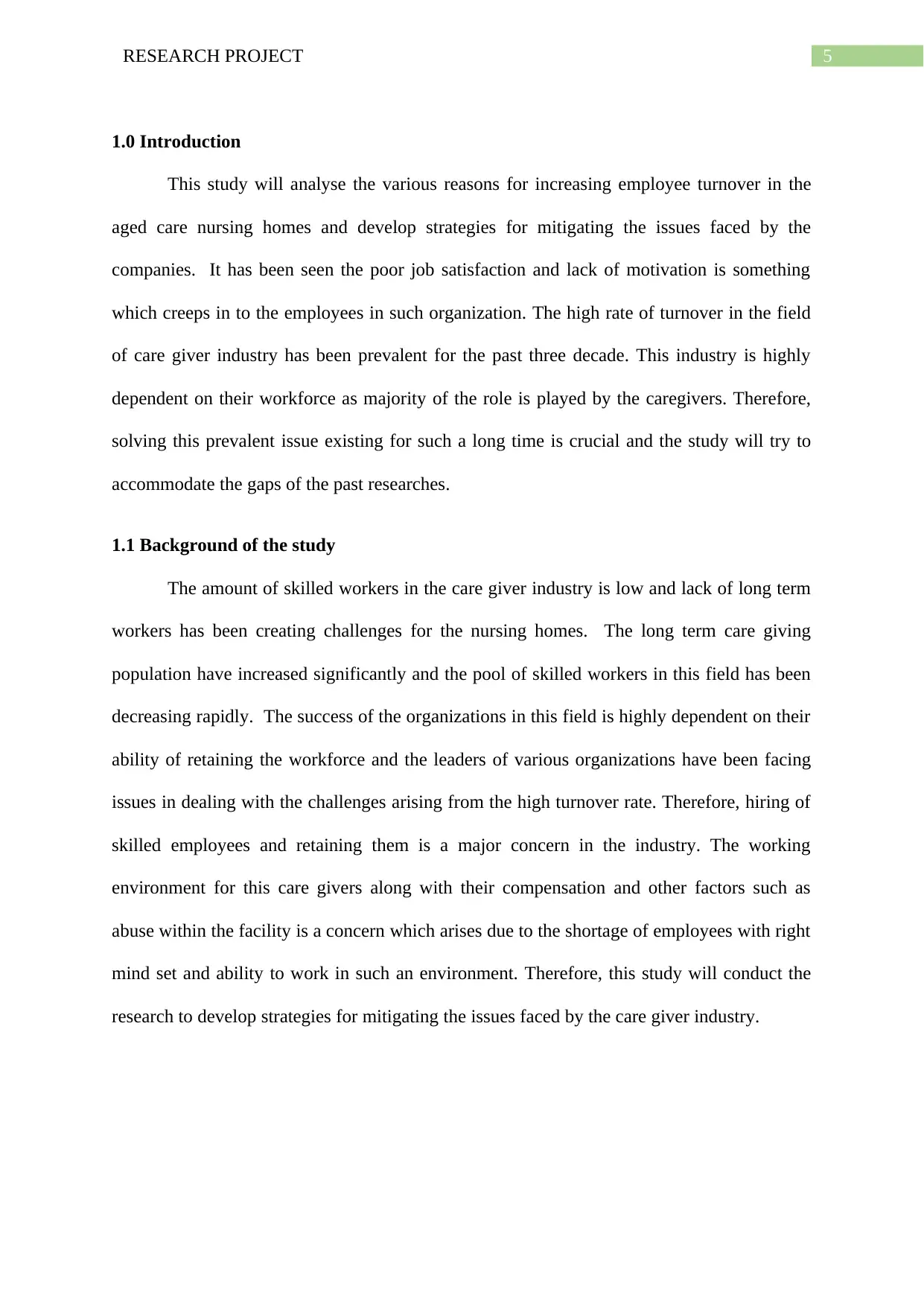
5RESEARCH PROJECT
1.0 Introduction
This study will analyse the various reasons for increasing employee turnover in the
aged care nursing homes and develop strategies for mitigating the issues faced by the
companies. It has been seen the poor job satisfaction and lack of motivation is something
which creeps in to the employees in such organization. The high rate of turnover in the field
of care giver industry has been prevalent for the past three decade. This industry is highly
dependent on their workforce as majority of the role is played by the caregivers. Therefore,
solving this prevalent issue existing for such a long time is crucial and the study will try to
accommodate the gaps of the past researches.
1.1 Background of the study
The amount of skilled workers in the care giver industry is low and lack of long term
workers has been creating challenges for the nursing homes. The long term care giving
population have increased significantly and the pool of skilled workers in this field has been
decreasing rapidly. The success of the organizations in this field is highly dependent on their
ability of retaining the workforce and the leaders of various organizations have been facing
issues in dealing with the challenges arising from the high turnover rate. Therefore, hiring of
skilled employees and retaining them is a major concern in the industry. The working
environment for this care givers along with their compensation and other factors such as
abuse within the facility is a concern which arises due to the shortage of employees with right
mind set and ability to work in such an environment. Therefore, this study will conduct the
research to develop strategies for mitigating the issues faced by the care giver industry.
1.0 Introduction
This study will analyse the various reasons for increasing employee turnover in the
aged care nursing homes and develop strategies for mitigating the issues faced by the
companies. It has been seen the poor job satisfaction and lack of motivation is something
which creeps in to the employees in such organization. The high rate of turnover in the field
of care giver industry has been prevalent for the past three decade. This industry is highly
dependent on their workforce as majority of the role is played by the caregivers. Therefore,
solving this prevalent issue existing for such a long time is crucial and the study will try to
accommodate the gaps of the past researches.
1.1 Background of the study
The amount of skilled workers in the care giver industry is low and lack of long term
workers has been creating challenges for the nursing homes. The long term care giving
population have increased significantly and the pool of skilled workers in this field has been
decreasing rapidly. The success of the organizations in this field is highly dependent on their
ability of retaining the workforce and the leaders of various organizations have been facing
issues in dealing with the challenges arising from the high turnover rate. Therefore, hiring of
skilled employees and retaining them is a major concern in the industry. The working
environment for this care givers along with their compensation and other factors such as
abuse within the facility is a concern which arises due to the shortage of employees with right
mind set and ability to work in such an environment. Therefore, this study will conduct the
research to develop strategies for mitigating the issues faced by the care giver industry.
⊘ This is a preview!⊘
Do you want full access?
Subscribe today to unlock all pages.

Trusted by 1+ million students worldwide
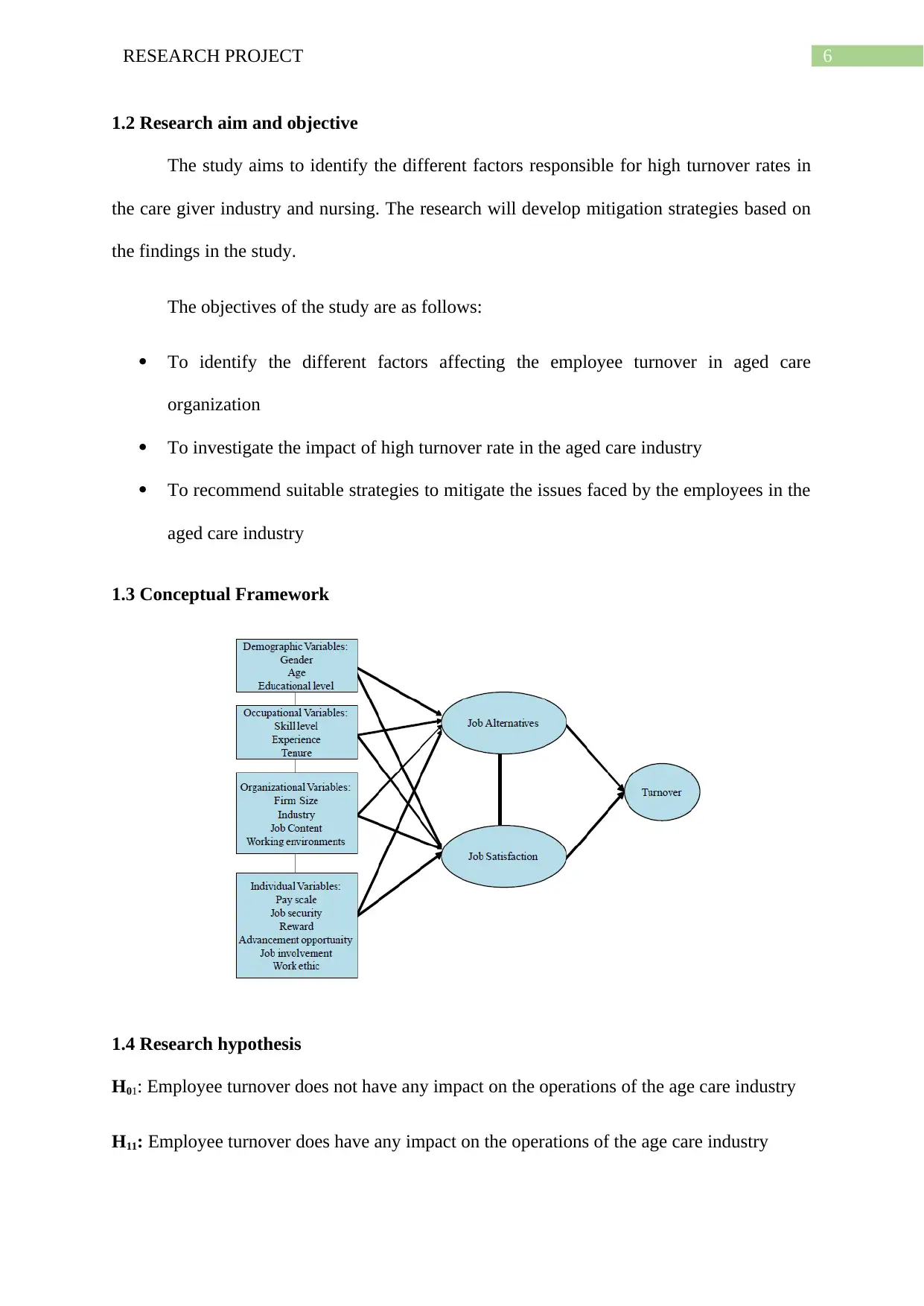
6RESEARCH PROJECT
1.2 Research aim and objective
The study aims to identify the different factors responsible for high turnover rates in
the care giver industry and nursing. The research will develop mitigation strategies based on
the findings in the study.
The objectives of the study are as follows:
To identify the different factors affecting the employee turnover in aged care
organization
To investigate the impact of high turnover rate in the aged care industry
To recommend suitable strategies to mitigate the issues faced by the employees in the
aged care industry
1.3 Conceptual Framework
1.4 Research hypothesis
H01: Employee turnover does not have any impact on the operations of the age care industry
H11: Employee turnover does have any impact on the operations of the age care industry
1.2 Research aim and objective
The study aims to identify the different factors responsible for high turnover rates in
the care giver industry and nursing. The research will develop mitigation strategies based on
the findings in the study.
The objectives of the study are as follows:
To identify the different factors affecting the employee turnover in aged care
organization
To investigate the impact of high turnover rate in the aged care industry
To recommend suitable strategies to mitigate the issues faced by the employees in the
aged care industry
1.3 Conceptual Framework
1.4 Research hypothesis
H01: Employee turnover does not have any impact on the operations of the age care industry
H11: Employee turnover does have any impact on the operations of the age care industry
Paraphrase This Document
Need a fresh take? Get an instant paraphrase of this document with our AI Paraphraser
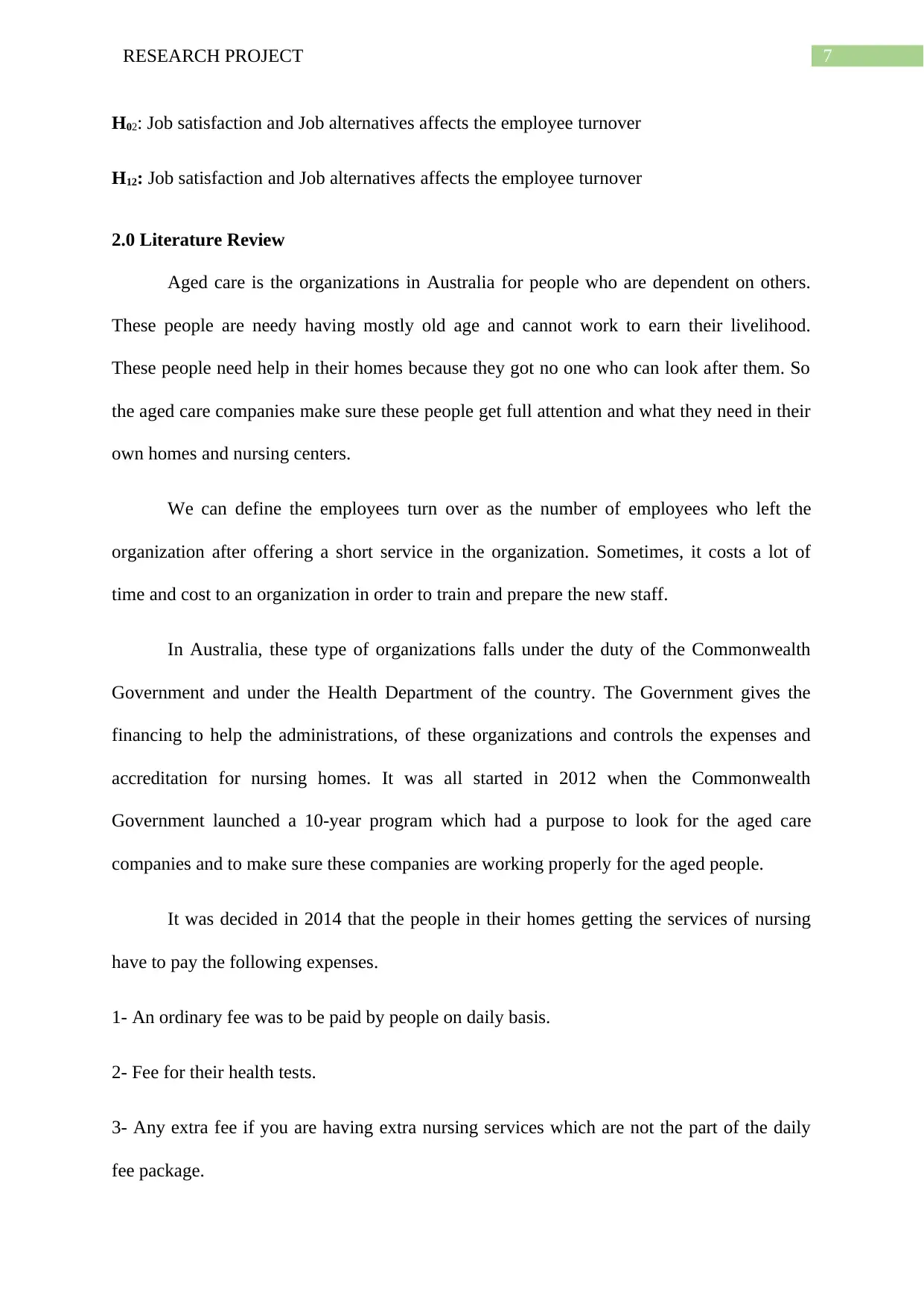
7RESEARCH PROJECT
H02: Job satisfaction and Job alternatives affects the employee turnover
H12: Job satisfaction and Job alternatives affects the employee turnover
2.0 Literature Review
Aged care is the organizations in Australia for people who are dependent on others.
These people are needy having mostly old age and cannot work to earn their livelihood.
These people need help in their homes because they got no one who can look after them. So
the aged care companies make sure these people get full attention and what they need in their
own homes and nursing centers.
We can define the employees turn over as the number of employees who left the
organization after offering a short service in the organization. Sometimes, it costs a lot of
time and cost to an organization in order to train and prepare the new staff.
In Australia, these type of organizations falls under the duty of the Commonwealth
Government and under the Health Department of the country. The Government gives the
financing to help the administrations, of these organizations and controls the expenses and
accreditation for nursing homes. It was all started in 2012 when the Commonwealth
Government launched a 10-year program which had a purpose to look for the aged care
companies and to make sure these companies are working properly for the aged people.
It was decided in 2014 that the people in their homes getting the services of nursing
have to pay the following expenses.
1- An ordinary fee was to be paid by people on daily basis.
2- Fee for their health tests.
3- Any extra fee if you are having extra nursing services which are not the part of the daily
fee package.
H02: Job satisfaction and Job alternatives affects the employee turnover
H12: Job satisfaction and Job alternatives affects the employee turnover
2.0 Literature Review
Aged care is the organizations in Australia for people who are dependent on others.
These people are needy having mostly old age and cannot work to earn their livelihood.
These people need help in their homes because they got no one who can look after them. So
the aged care companies make sure these people get full attention and what they need in their
own homes and nursing centers.
We can define the employees turn over as the number of employees who left the
organization after offering a short service in the organization. Sometimes, it costs a lot of
time and cost to an organization in order to train and prepare the new staff.
In Australia, these type of organizations falls under the duty of the Commonwealth
Government and under the Health Department of the country. The Government gives the
financing to help the administrations, of these organizations and controls the expenses and
accreditation for nursing homes. It was all started in 2012 when the Commonwealth
Government launched a 10-year program which had a purpose to look for the aged care
companies and to make sure these companies are working properly for the aged people.
It was decided in 2014 that the people in their homes getting the services of nursing
have to pay the following expenses.
1- An ordinary fee was to be paid by people on daily basis.
2- Fee for their health tests.
3- Any extra fee if you are having extra nursing services which are not the part of the daily
fee package.
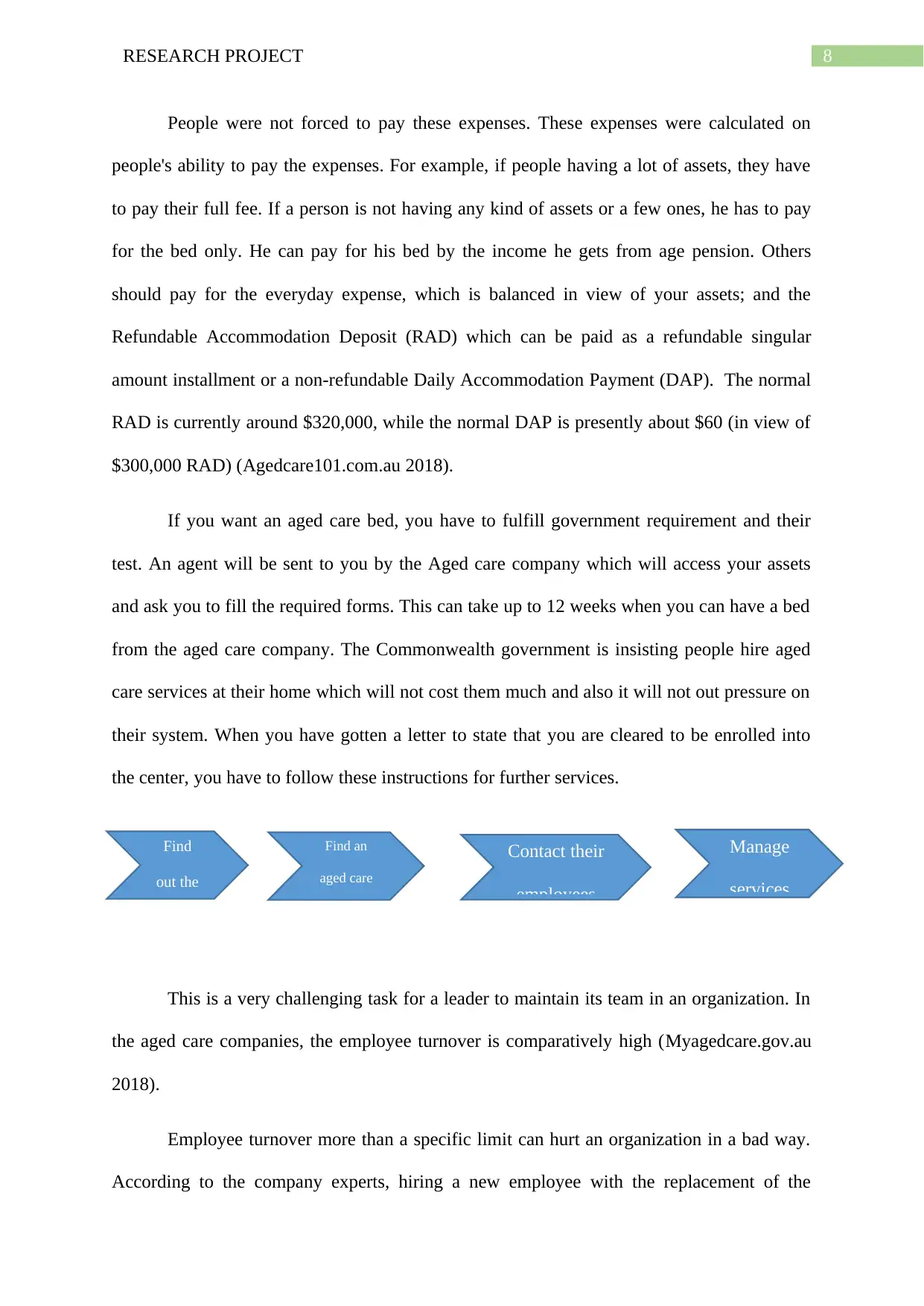
8RESEARCH PROJECT
People were not forced to pay these expenses. These expenses were calculated on
people's ability to pay the expenses. For example, if people having a lot of assets, they have
to pay their full fee. If a person is not having any kind of assets or a few ones, he has to pay
for the bed only. He can pay for his bed by the income he gets from age pension. Others
should pay for the everyday expense, which is balanced in view of your assets; and the
Refundable Accommodation Deposit (RAD) which can be paid as a refundable singular
amount installment or a non-refundable Daily Accommodation Payment (DAP). The normal
RAD is currently around $320,000, while the normal DAP is presently about $60 (in view of
$300,000 RAD) (Agedcare101.com.au 2018).
If you want an aged care bed, you have to fulfill government requirement and their
test. An agent will be sent to you by the Aged care company which will access your assets
and ask you to fill the required forms. This can take up to 12 weeks when you can have a bed
from the aged care company. The Commonwealth government is insisting people hire aged
care services at their home which will not cost them much and also it will not out pressure on
their system. When you have gotten a letter to state that you are cleared to be enrolled into
the center, you have to follow these instructions for further services.
This is a very challenging task for a leader to maintain its team in an organization. In
the aged care companies, the employee turnover is comparatively high (Myagedcare.gov.au
2018).
Employee turnover more than a specific limit can hurt an organization in a bad way.
According to the company experts, hiring a new employee with the replacement of the
Find
out the
cost
Find an
aged care
home
Manage
services
Contact their
employees
People were not forced to pay these expenses. These expenses were calculated on
people's ability to pay the expenses. For example, if people having a lot of assets, they have
to pay their full fee. If a person is not having any kind of assets or a few ones, he has to pay
for the bed only. He can pay for his bed by the income he gets from age pension. Others
should pay for the everyday expense, which is balanced in view of your assets; and the
Refundable Accommodation Deposit (RAD) which can be paid as a refundable singular
amount installment or a non-refundable Daily Accommodation Payment (DAP). The normal
RAD is currently around $320,000, while the normal DAP is presently about $60 (in view of
$300,000 RAD) (Agedcare101.com.au 2018).
If you want an aged care bed, you have to fulfill government requirement and their
test. An agent will be sent to you by the Aged care company which will access your assets
and ask you to fill the required forms. This can take up to 12 weeks when you can have a bed
from the aged care company. The Commonwealth government is insisting people hire aged
care services at their home which will not cost them much and also it will not out pressure on
their system. When you have gotten a letter to state that you are cleared to be enrolled into
the center, you have to follow these instructions for further services.
This is a very challenging task for a leader to maintain its team in an organization. In
the aged care companies, the employee turnover is comparatively high (Myagedcare.gov.au
2018).
Employee turnover more than a specific limit can hurt an organization in a bad way.
According to the company experts, hiring a new employee with the replacement of the
Find
out the
cost
Find an
aged care
home
Manage
services
Contact their
employees
⊘ This is a preview!⊘
Do you want full access?
Subscribe today to unlock all pages.

Trusted by 1+ million students worldwide
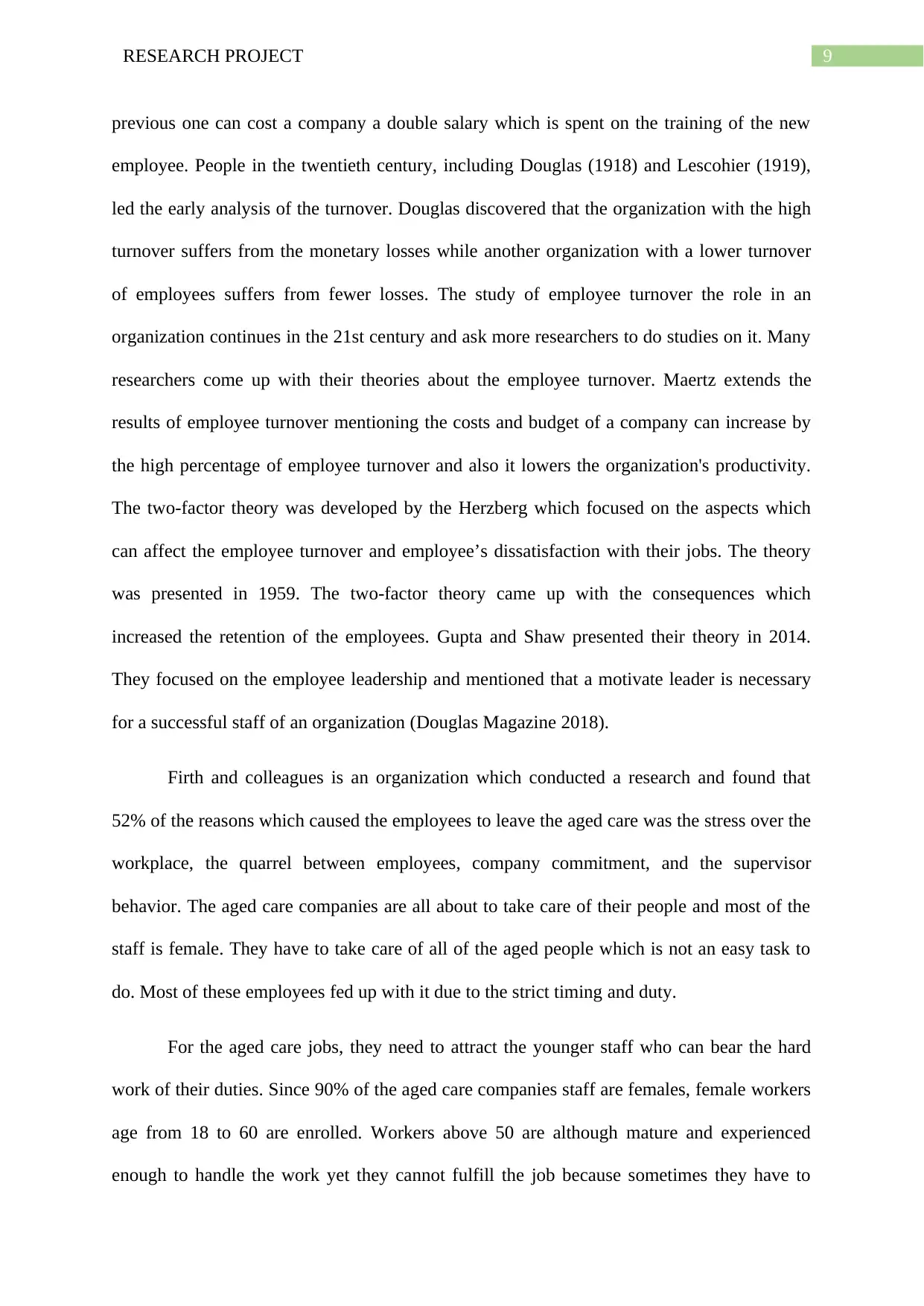
9RESEARCH PROJECT
previous one can cost a company a double salary which is spent on the training of the new
employee. People in the twentieth century, including Douglas (1918) and Lescohier (1919),
led the early analysis of the turnover. Douglas discovered that the organization with the high
turnover suffers from the monetary losses while another organization with a lower turnover
of employees suffers from fewer losses. The study of employee turnover the role in an
organization continues in the 21st century and ask more researchers to do studies on it. Many
researchers come up with their theories about the employee turnover. Maertz extends the
results of employee turnover mentioning the costs and budget of a company can increase by
the high percentage of employee turnover and also it lowers the organization's productivity.
The two-factor theory was developed by the Herzberg which focused on the aspects which
can affect the employee turnover and employee’s dissatisfaction with their jobs. The theory
was presented in 1959. The two-factor theory came up with the consequences which
increased the retention of the employees. Gupta and Shaw presented their theory in 2014.
They focused on the employee leadership and mentioned that a motivate leader is necessary
for a successful staff of an organization (Douglas Magazine 2018).
Firth and colleagues is an organization which conducted a research and found that
52% of the reasons which caused the employees to leave the aged care was the stress over the
workplace, the quarrel between employees, company commitment, and the supervisor
behavior. The aged care companies are all about to take care of their people and most of the
staff is female. They have to take care of all of the aged people which is not an easy task to
do. Most of these employees fed up with it due to the strict timing and duty.
For the aged care jobs, they need to attract the younger staff who can bear the hard
work of their duties. Since 90% of the aged care companies staff are females, female workers
age from 18 to 60 are enrolled. Workers above 50 are although mature and experienced
enough to handle the work yet they cannot fulfill the job because sometimes they have to
previous one can cost a company a double salary which is spent on the training of the new
employee. People in the twentieth century, including Douglas (1918) and Lescohier (1919),
led the early analysis of the turnover. Douglas discovered that the organization with the high
turnover suffers from the monetary losses while another organization with a lower turnover
of employees suffers from fewer losses. The study of employee turnover the role in an
organization continues in the 21st century and ask more researchers to do studies on it. Many
researchers come up with their theories about the employee turnover. Maertz extends the
results of employee turnover mentioning the costs and budget of a company can increase by
the high percentage of employee turnover and also it lowers the organization's productivity.
The two-factor theory was developed by the Herzberg which focused on the aspects which
can affect the employee turnover and employee’s dissatisfaction with their jobs. The theory
was presented in 1959. The two-factor theory came up with the consequences which
increased the retention of the employees. Gupta and Shaw presented their theory in 2014.
They focused on the employee leadership and mentioned that a motivate leader is necessary
for a successful staff of an organization (Douglas Magazine 2018).
Firth and colleagues is an organization which conducted a research and found that
52% of the reasons which caused the employees to leave the aged care was the stress over the
workplace, the quarrel between employees, company commitment, and the supervisor
behavior. The aged care companies are all about to take care of their people and most of the
staff is female. They have to take care of all of the aged people which is not an easy task to
do. Most of these employees fed up with it due to the strict timing and duty.
For the aged care jobs, they need to attract the younger staff who can bear the hard
work of their duties. Since 90% of the aged care companies staff are females, female workers
age from 18 to 60 are enrolled. Workers above 50 are although mature and experienced
enough to handle the work yet they cannot fulfill the job because sometimes they have to
Paraphrase This Document
Need a fresh take? Get an instant paraphrase of this document with our AI Paraphraser
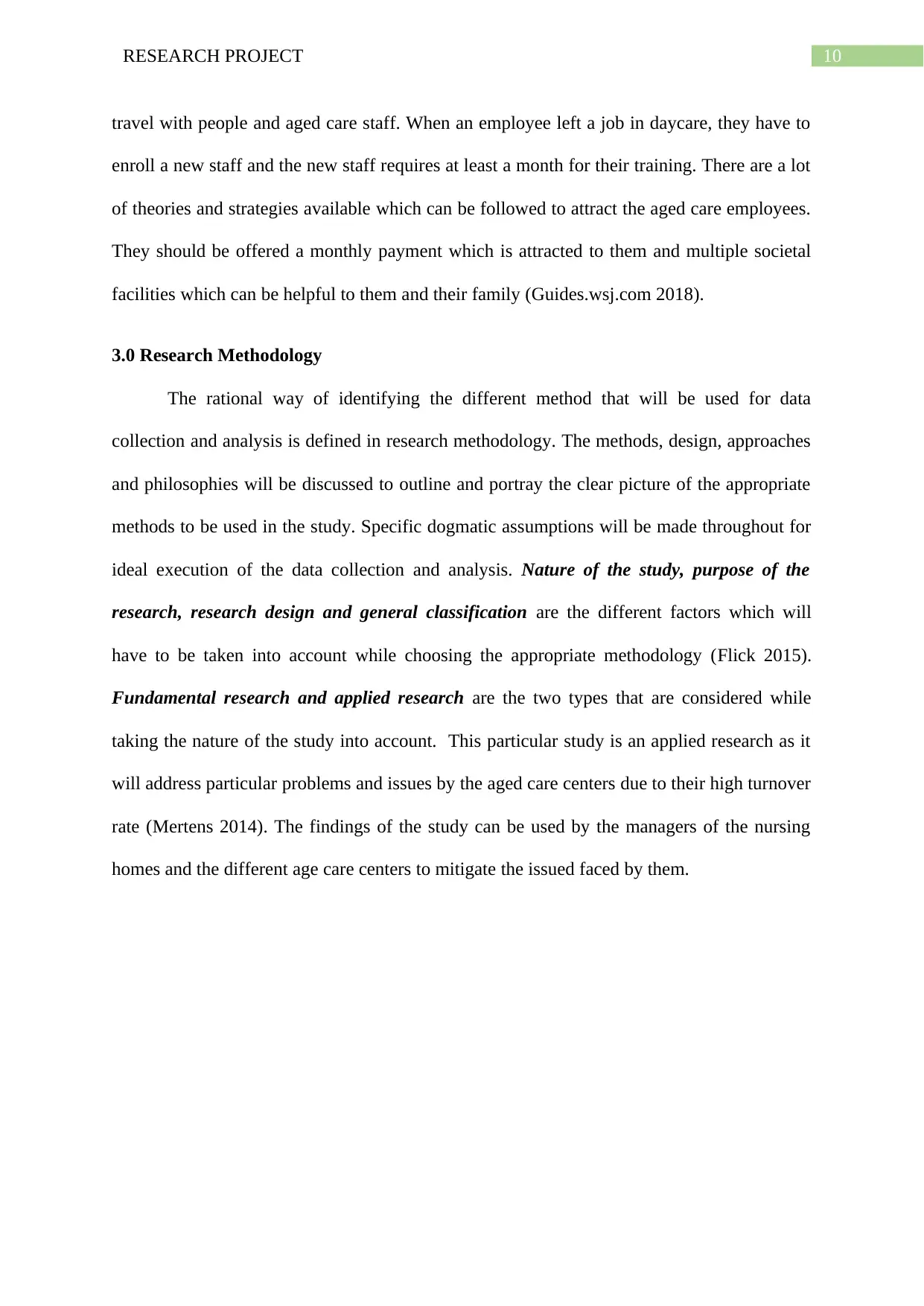
10RESEARCH PROJECT
travel with people and aged care staff. When an employee left a job in daycare, they have to
enroll a new staff and the new staff requires at least a month for their training. There are a lot
of theories and strategies available which can be followed to attract the aged care employees.
They should be offered a monthly payment which is attracted to them and multiple societal
facilities which can be helpful to them and their family (Guides.wsj.com 2018).
3.0 Research Methodology
The rational way of identifying the different method that will be used for data
collection and analysis is defined in research methodology. The methods, design, approaches
and philosophies will be discussed to outline and portray the clear picture of the appropriate
methods to be used in the study. Specific dogmatic assumptions will be made throughout for
ideal execution of the data collection and analysis. Nature of the study, purpose of the
research, research design and general classification are the different factors which will
have to be taken into account while choosing the appropriate methodology (Flick 2015).
Fundamental research and applied research are the two types that are considered while
taking the nature of the study into account. This particular study is an applied research as it
will address particular problems and issues by the aged care centers due to their high turnover
rate (Mertens 2014). The findings of the study can be used by the managers of the nursing
homes and the different age care centers to mitigate the issued faced by them.
travel with people and aged care staff. When an employee left a job in daycare, they have to
enroll a new staff and the new staff requires at least a month for their training. There are a lot
of theories and strategies available which can be followed to attract the aged care employees.
They should be offered a monthly payment which is attracted to them and multiple societal
facilities which can be helpful to them and their family (Guides.wsj.com 2018).
3.0 Research Methodology
The rational way of identifying the different method that will be used for data
collection and analysis is defined in research methodology. The methods, design, approaches
and philosophies will be discussed to outline and portray the clear picture of the appropriate
methods to be used in the study. Specific dogmatic assumptions will be made throughout for
ideal execution of the data collection and analysis. Nature of the study, purpose of the
research, research design and general classification are the different factors which will
have to be taken into account while choosing the appropriate methodology (Flick 2015).
Fundamental research and applied research are the two types that are considered while
taking the nature of the study into account. This particular study is an applied research as it
will address particular problems and issues by the aged care centers due to their high turnover
rate (Mertens 2014). The findings of the study can be used by the managers of the nursing
homes and the different age care centers to mitigate the issued faced by them.
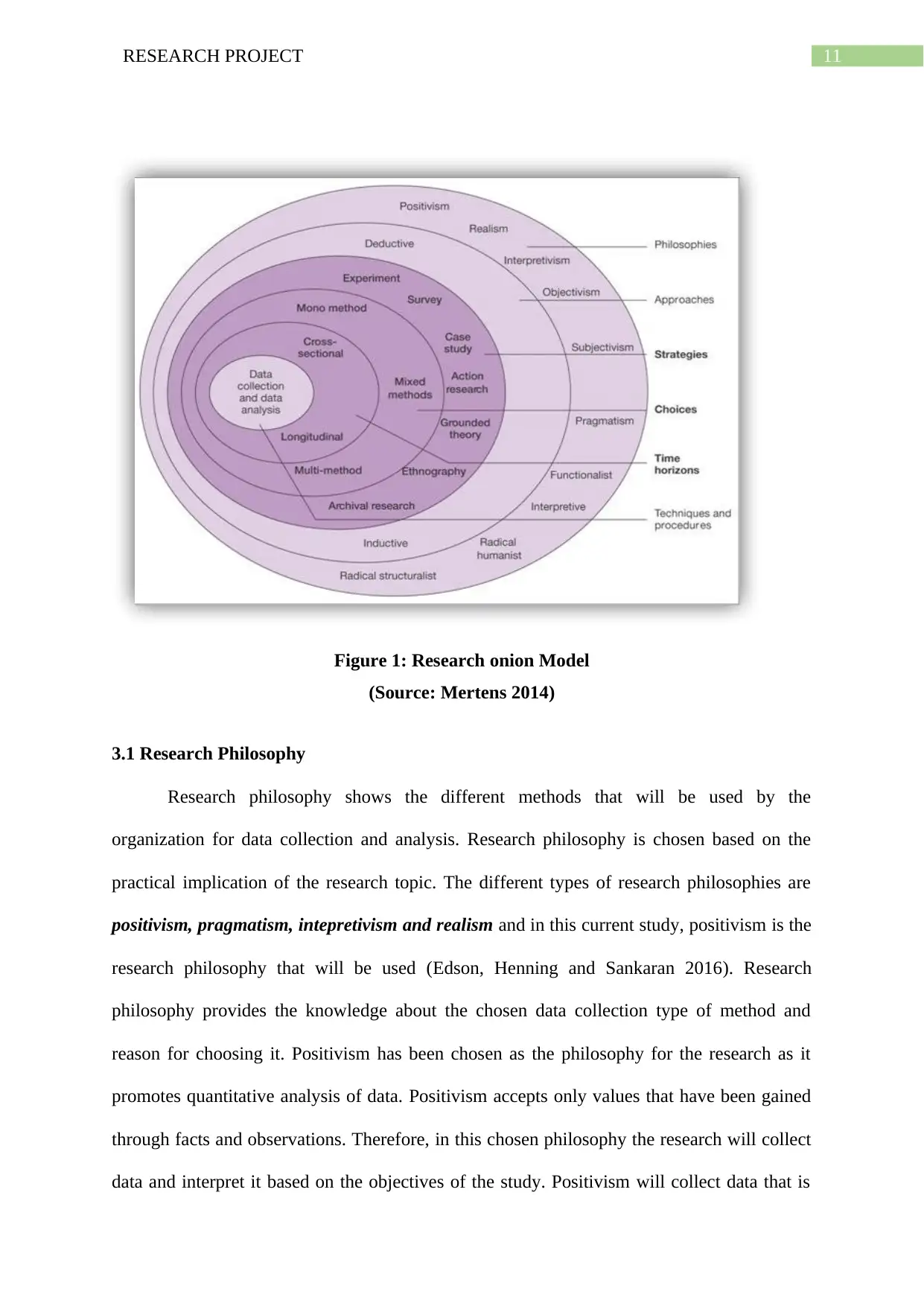
11RESEARCH PROJECT
Figure 1: Research onion Model
(Source: Mertens 2014)
3.1 Research Philosophy
Research philosophy shows the different methods that will be used by the
organization for data collection and analysis. Research philosophy is chosen based on the
practical implication of the research topic. The different types of research philosophies are
positivism, pragmatism, intepretivism and realism and in this current study, positivism is the
research philosophy that will be used (Edson, Henning and Sankaran 2016). Research
philosophy provides the knowledge about the chosen data collection type of method and
reason for choosing it. Positivism has been chosen as the philosophy for the research as it
promotes quantitative analysis of data. Positivism accepts only values that have been gained
through facts and observations. Therefore, in this chosen philosophy the research will collect
data and interpret it based on the objectives of the study. Positivism will collect data that is
Figure 1: Research onion Model
(Source: Mertens 2014)
3.1 Research Philosophy
Research philosophy shows the different methods that will be used by the
organization for data collection and analysis. Research philosophy is chosen based on the
practical implication of the research topic. The different types of research philosophies are
positivism, pragmatism, intepretivism and realism and in this current study, positivism is the
research philosophy that will be used (Edson, Henning and Sankaran 2016). Research
philosophy provides the knowledge about the chosen data collection type of method and
reason for choosing it. Positivism has been chosen as the philosophy for the research as it
promotes quantitative analysis of data. Positivism accepts only values that have been gained
through facts and observations. Therefore, in this chosen philosophy the research will collect
data and interpret it based on the objectives of the study. Positivism will collect data that is
⊘ This is a preview!⊘
Do you want full access?
Subscribe today to unlock all pages.

Trusted by 1+ million students worldwide
1 out of 43
Related Documents
Your All-in-One AI-Powered Toolkit for Academic Success.
+13062052269
info@desklib.com
Available 24*7 on WhatsApp / Email
![[object Object]](/_next/static/media/star-bottom.7253800d.svg)
Unlock your academic potential
Copyright © 2020–2025 A2Z Services. All Rights Reserved. Developed and managed by ZUCOL.





